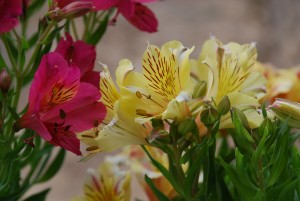Peruvian lilies (Alstroemeria spp.), also called Lilies of the Nile), are not true lilies (Lilium spp.). Likely, you have purchased a bouquet of alstroemerias from the florist section of your local supermarket. In addition, many potted hybrid varieties have been introduced from Holland and elsewhere over the past decade.
Turns out that some Peruvian lilies are perennials, winter hardy in the Southern Appalachian Region (USDA hardiness zones 6 and 7). Perennial types are best suited for an east front border of the flower garden, exposed to mostly morning sunlight. In the deep South (zones 8 and 9), they prefer filtered (not direct) sunlight through nearby trees.
Afternoon sunlight is harsh in the summer on the leaves and reduces flower life. Mulch around plants in late fall in colder zones 5-b to 6-a climates or transplant back into a container and grow them in a cool garden room over the winter.
Peruvian lilies require little care after planting. Fertilize established plants in late winter with a handful of granular 10-10-10 around each plant. Irrigate Peruvian lilies weekly, particularly during summer dry spells.
Peruvian lilies comes in several flower colors including in white, yellow, salmon, pink and red. Perennial varieties average 18-36 inches in height in garden beds and in deck or patio containers. Cut flowers may last for 7 to 10 days.


 Posted in
Posted in 
